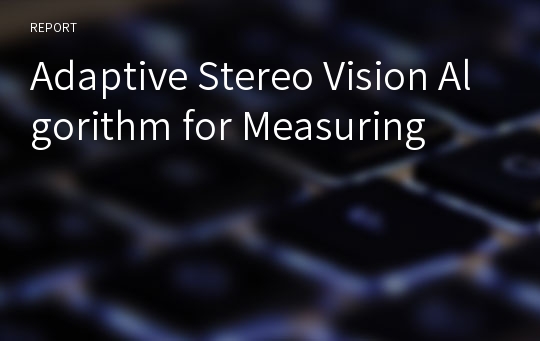Adaptive Stereo Vision Algorithm for Measuring
*영*
다운로드
장바구니
목차
1. Introduction2. Stereo Vision System
3. Suggested System
4. Simulation Results and Discussions
5. Conclusion
본문내용
AbstractStereo vision algorithm is used to measure the distance between a fixed camera and an unknown object. Stereo vision method is suitable for giving an approximate measure of distance between a fixed camera and an object. Therefore, this method is inappropriate for an inspection application where very accurate results are needed. In this paper, the researchers propose an adaptive method suitable for measuring the height of small objects, such as microchips, with high accuracy.
1. Introduction
Nowadays machine vision based systems are becoming popular. A vision based system has several advantages. First, it is fast due to the development of a powerful camera system and computer. It is suitable for industrial system that needs real time inspection. Second it is very flexible. For the last few decades, a lot of vision algorithms have been developed, such as feature detection
<중 략>
Figure 7. Measurement session.
3.4. 3D measurement process of the proposed system
The process of the 3D measurement for proposed adaptive vision system can be summarized as follows. There are training session and measurement session.
A. Training session
1. Obtain the images of a known object from the left and right cameras.
2. Extract the matching points of the feature of the object from the left and right images.
3. Estimate the height of a known object from the vision system.
4. Estimate optimal weight vector using LMS method.
참고 자료
S. Bahadori and L. Iocchi.: “A Stereo Vision System for 3D Reconstruction and Semi-Automatic Surveillance of Museum Areas,” 2007. (University-funded study). Retrieved from http://citeseerx.ist.psu.edu/viewdoc/summary?doi=10.1.1.59.8237N. Uchida, et. al.: “3D Face Recognition Using Passive Stereo Vision,” in Proc. of the IEEE International Conference on Image Processing (ICIP), vol.3, no.2, pp.950-953, 2005.
P. Shrivasthava and P.R. Vundavilli, “An Approach for 3D Reconstruction of Environment Using Stereo-Vision System,” in Proc. of the IEEE Region 10 Colloquium and the Third International Conference on Industrial and Information Systems, pp.1-7, 2008.
B. Widrow and M. Kamenetsky, “Statistical Efficiency of Adaptive Algorithms,” Neural Networks, vol.16, pp.735.744, 2003.
M. Givens, “Enhanced-Convergence Normalized LMS Algorithm,” IEEE Signal Processing Magazine, vol.26, no.3, pp.81-95, 2009.
T. Aboulnasr and K. Mayyas, “A Robust Variable Step-Size LMS-Type Algorithm: Analysis and Simulation,”in Proc. of the International Conference on Acoustics, Speech, and Signal Processing (ICASSP), vol.2, pp.1408-1411, 1995.
Z. Zhang, “A Flexible New Technique for Camera Calibration,” in Proc. of the IEEE Transactions on Pattern Analysis and Machine Intelligence, vol.22, no. 11, pp.1330-1334, 2000.
R. Hartley, “Theory and Practice of Projective Rectification,” International Journal of Computer Vision, vol.35, no.12, pp.115-127, 1999.
J.Y. Bouguet, “Camera Calibration Toolbox for Matlab: Fifth Calibration Example: Calibrating a Stereo System, Stereo Image rectification and 3D stereo triangulation,” Retrieved from California Institute of Technology, Computational Vision Website:http://www.vision.caltech.edu/bouguetj/calib_doc/htmls/example5.html.
R. A. Lande and N. A. Thacker, “Tutorial: Overview of Stereo Matching Research,” from Tina Memos: Human and Machine Vision Website: http://www.tina-vision.net/docs/memos/1994-001.pdf.
D. G. Lowe, “Distinctive Image Features from Scale-Invariant Keypoints,” International Journal of Computer Vision, vol.60, pp.91.110, 2004.
R. Hartley and A. Zisserman, “Multiple View Geometry in Computer Vision,” Cambridge, UK: Cambridge University Press, 2006.
R. J. Schilling and S. L. Harris, “Fundamentals of Digital Signal Processing Using MATLAB, 2nd ed.,” Cengage Learning: Florence, KY, 2005.





























